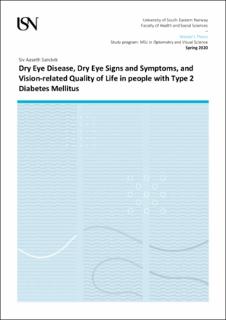| dc.description.abstract | Purpose
The aim of this study is to investigate dry eye disease (DED), dry eye signs and symptoms among people with type 2 diabetes mellitus (DM2), and the association between DED and dry eye signs and symptoms and Visual Quality of Life (VQoL).
Methods
This study has a cross-sectional design within the study population of people with DM2. The sample comprised people with DM2 recruited to the research project Diabetes, Vision, and Ocular Health at the University of South-Eastern Norway. In all, 89 participants underwent an eye examination with a dry eye work-up at the University of South-Eastern Norway during the period August 2018 to June 2019. Results are reported from the self-administered National Eye Institute Visual Function Questionnaire (NEI-VFQ-25), the Ocular Surface Disease Index (OSDI) questionnaire, and an extensive dry eye work-up according to the Tear Film and Ocular Surface Society
(TFOS) Dry eye Workshop (DEWS) II report. DED was defined by an OSDI score ≥13 and the presence of a positive score for at least one of the homeostasis markers: tear film break-up time, osmolarity, or ocular surface staining. In addition, tear meniscus height, Schirmer test, and meibomian gland function were evaluated. Data were analyzed with frequency and summation tables and IBM SPSS Statistics 26 using standard statistical tests to assess group differences and associations. These included chi-square, Mann-Whitney U-test, Spearman’s rho, and multivariate linear regression analysis. A p-value < 0.05 was considered significant. The study was approved by the Regional Committees for Medical Research Ethics (2018/804/REK sør-øst).
Results
The mean (sd) age of the participants was 65 (±10) years. The sample included 39 (44%) females and 50 (56%) males. Their mean duration for DM2 was 10 (±7) years. The mean (±sd) OSDI score for all participants was 8.0 (±10), and 24.9 (±10.1) and 4.2 (±3.9) for people with and without DED, respectively. In all, 16 (18%) were diagnosed with DED 95%CI [10.6, 27.5]. Most participants had at least one positive homeostasis marker: cular surface staining > 5; corneal spots > 9; conjunctival spots or lid margin staining > 2 mm and ≥ 25% width; positive osmolarity ≥ 308 mOsm/L in either eye; intraocular difference > 8 mOsm/L; or positive non-invasive tear breakup time (NIBUT) < 10 s. No correlations between dry eye symptoms and signs were observed. The overall mean
(sd) composite NEI-VFQ-25 score was 87.43 (±10.37) and the ocular pain subscale score was 83.01 (±17.80). A Mann-Whitney test indicated that the overall composite NEI-VFQ-25 score was lower for those with DED (Mdn = 19.14) than for those without DED (Mdn = 45.0 ), (U =163, p < .001) and those with DED had more ocular pain (Mdn = 28.1) than those without (Mdn = 47.6), (U = 313, p = .004). In a linear regression model, adjusting age, gender, diabetes duration, and best corrected visual acuity at distance (BCVAD), DED was significantly correlated with the following NEI-VFQ-25 subscales: ocular pain, distance activities, social functioning, mental health, role difficulties, dependency, driving, and peripheral vision. In a multivariate linear regression model, adjusting for age, gender, diabetes duration and BCVA at distance, DED was an independent predictor only for the ocular pain score.
Conclusion
It was found that people with DM2 have a low prevalence of DED, but a substantial prevalence of clinical findings of DED. Symptoms and the clinical signs of DED are not associated. The correlation between DED and the composite score for NEI-VFQ-25 and the subscale score for ocular pain is fair and DED can be identified as an independent predictor of ocular pain. However, people with DM2 may have severe clinical surface damage without having symptoms. The OSDI questionnaire is not a reliable discriminative test for clinical findings of dry eye and ocular surface disease in people with DM2. Routine examination of the lids and ocular surface of people with DM2 is vital, as detection of ocular surface damage is important for early treatment and prevention of vision threatening complications. | en_US |
